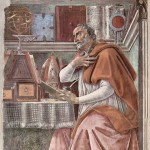
Joseph Desa (1603-1663) was born in Cupertino, near Brindisi in the Kingdom of Naples.
St. Joseph of Cupertino is a challenge to anyone of an intellectual bent. His life is the prototypic story of an uneducated child, beset by poverty, who has ecstatic experiences beginning at age 8 which leave his mouth agape. His school mates called him “voca aperta.” The young child had quite a temper, which his mother tried to moderate, and he was later apprenticed to a shoemaker. At 17 he was turned away from the Friars Minor Conventual because of his ignorance. The Capuchins at first accepted him as a lay brother but his continued ecstasies made it impossible for him to do his work, so he found himself out on the street again. His mother and his uncles had given up on him and abused him as a good for nothing. Finally, after repeated prayers and a lot of tears he was allowed to work in the stable at the Franciscan convent of La Grotella near Cupertino. He was basically a lay servant. His humility, obedience, and love of penance must have impressed the friars because he was not only allowed to became a cleric but he was also ordained a priest over a period of years. Despite his lack of education, he demonstrated an amazing knowledge which appeared to be infused as a mystical gift. He was able to solve intricate problems.
His life was one long series of episodes of ecstasy, vision, and levitation. His superiors had to keep sending him from convent to convent to escape the curious.
John Coulson in his brief biography relates an incident that was all too typical.
“In 1645 the Spanish ambassador to the Holy See, the High Admiral of Castile, having spoken for some time with him in his cell at Assisi, said that his wife too would like to meet him. The Father Guardian told him to go down to the church: Joseph said he would obey but did not know whether he would be able to speak to her. He entered the church, saw a statue of our Lady over the altar and straightway flew some twelve paces above the onlookers to its feet, and after a while, ‘uttering his customary shrill cry’, returned to the floor and then his cell, having said nothing to the Admiral, his wife and their large retinue. Instances could be multiplied up to the last month of Joseph’s life.”
Through it all St. Joseph of Cupertino kept his sense of peace and humility. It almost seems as if his life was written as an object lesson about the need for men in religious orders to temper and even validate their spirituality through obedience. This is not an uncommon theme of the time. How much of this is history, legend, and myth?
The art of writing about the lives of saints – hagiography – has undergone extensive criticism in the last 100 years. St. Christopher, the patron saint of travelers, was removed from the Church calendar by the Vatican in 1969 because there wasn’t enough historical evidence that he had existed or had lived a life of holiness. Many lives of saints had become embellished over the centuries. For example, St. Nicholas was said to have stood up in the bathtub as an infant and preached a sermon.
In the 17th century, a group of Jesuit scholars, the Bollandists, were commissioned by the Pope to prepare a definitive collection of the Acta Sanctorum, The Lives of the Saints – or literally, the Deeds of the Saints. In a bow to the Enlightenment and rationalism, the resulting investigations cleared away a lot of misinformation and also validated significant historical information.
We might expect that the flying Franciscan would have been relegated to the dustbin of history. However, the historical testimony of Pope Urban VIII, who saw St. Joseph of Cupertino in ecstasy, the accounts of powerful nobles and officials who saw his miracles, and the records of the Inquisition, bear historical witness to a saint who baffled his contemporaries as much as he baffles us today.
St. Joseph of Cupertino defies our psychological categories. We could use the terms: hysteria, seizure disorders, aphasia, schizophrenia. Yet he certainly did not fit the social norm of insanity. Against the odds, his superiors judged him worthy of ordination to the priesthood, although his paranormal behavior prevented him from saying Mass in church and participating in processions. In 35 years he could not eat in the common dining room (refectory) or participate in the “choir” or singing of the Liturgy of the Hours (The Divine Office). His creativity in solving problems seems to remove him from the idiot savant category.
If we can’t explain away his behavior as a mental illness, then perhaps we are getting a glimpse of what it means to have a lifestyle of intense religious experience. If we leave science behind, we enter into the language of faith itself, or at a minimum, we enter the language of theoretical physics by talking about additional dimensions beyond the space-time continuum or the notion of parallel universes.
As I wrestle for some type of explanation, I feel that at any moment people will come rushing forward to tell me that I have made a fool of myself in front of some hidden camera. On the other hand, maybe that is what St. Joseph of Cupertino is all about.
1 Corinthians 1:26-31
Brothers, think of what you were when you were called. Not many of you were wise by human standards; not many were influential; not many were of noble birth. But God chose the foolish things of the world to shame the wise; God chose the weak things of the world to shame the strong. He chose the lowly things of this world and the despised things—and the things that are not—to nullify the things that are, so that no one may boast before him. It is because of him that you are in Christ Jesus, who has become for us wisdom from God—that is, our righteousness, holiness and redemption. Therefore, as it is written: “Let him who boasts boast in the Lord.”
Read More














